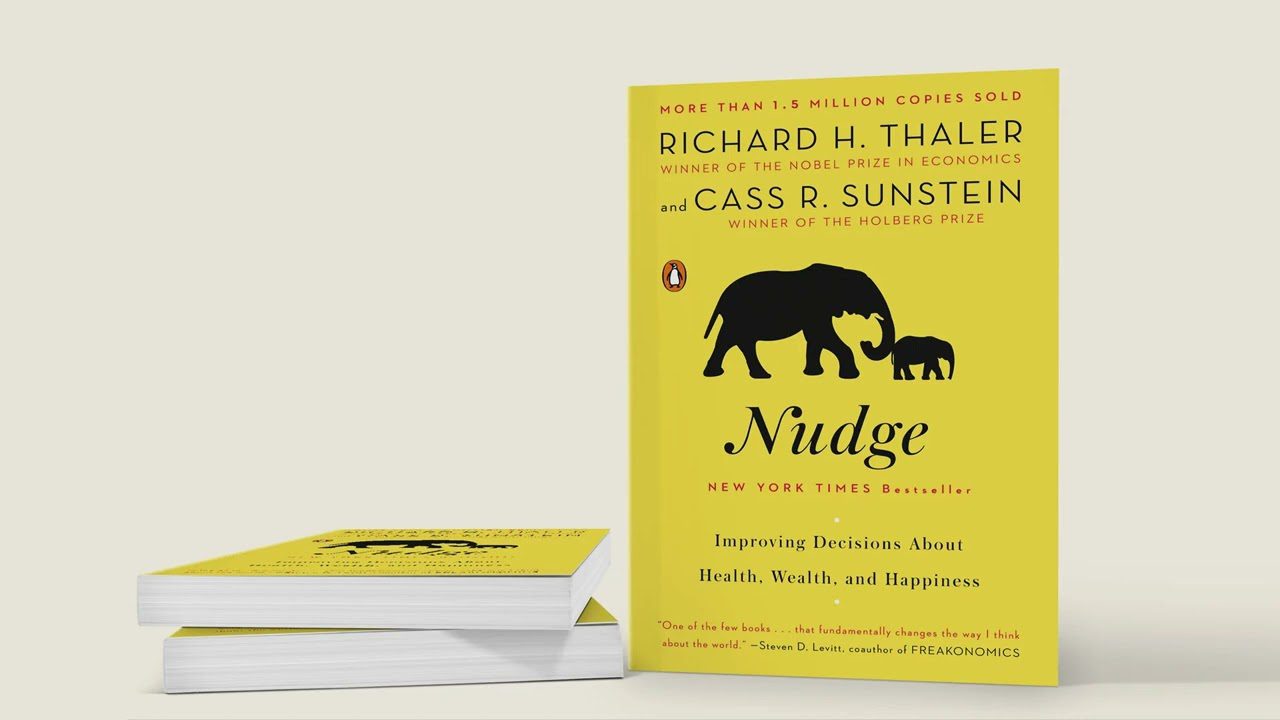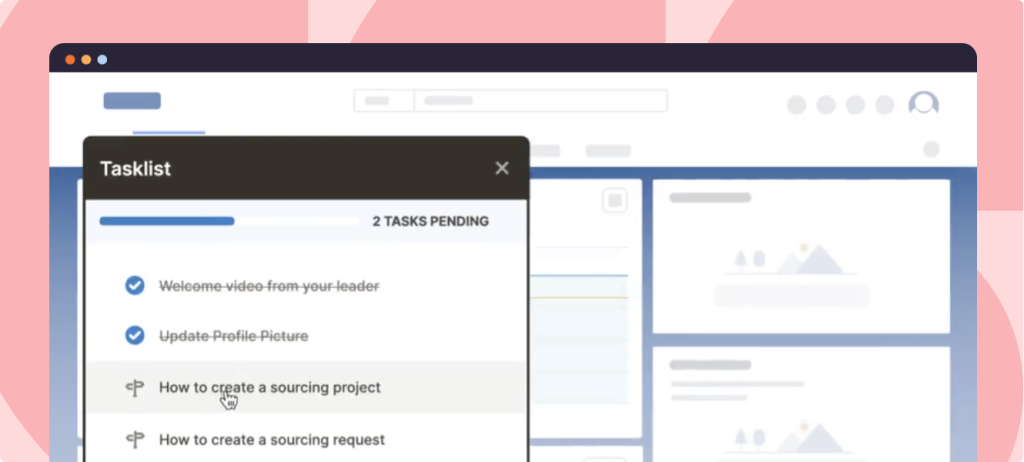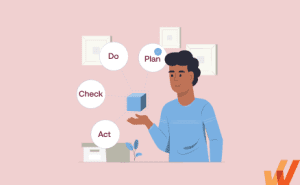The concept of nudge theory implies that you can influence people’s behavior, decisions, and opinions by:
- Modifying the decision-making environment (i.e. choice architecture).
- Using preset defaults.
- Changing how attributes are presented to highlight the options you want them to take.
Nudge theory is based on the idea that our choices are influenced by how those choices are presented to us.
This article will explore nudge theory from an enterprise change management perspective — how you can subtly influence your employees to utilize new software licenses, adopt better workflows, and make healthier productivity choices independently, without company-wide edicts that tend to feel restrictive.
What Is Nudge Theory?
“Nudge theory” is a behavioral science concept that proposes people’s decisions and behaviors can be influenced in predictable ways by small changes in how choices are presented.
This subtle method of influence, first coined by Richard H. Thaler and Cass R. Sunstein in their book “Nudge: Improving Decisions About Health, Wealth, and Happiness,” does not involve coercion or change of economic incentives. Instead, it relies on understanding how people think and make choices, incorporating cognitive psychology and behavioral economics insights to “nudge” people toward a particular decision or outcome.

What Is the History of Nudge Theory?
The groundwork for the idea of the nudge theory was laid by American behavioral scientists Richard H. Thaler and Cass R. Sunstein in their 2008 book titled Nudge: Improving Decisions About Health, Wealth, and Happiness.

For some background, Richard Thaler is a professor of Behavioral Science & Economics at the University of Chicago, former president of the American Economic Association, and recipient of the 2017 Nobel Prize in Economics; Cass Sunstein is a professor and the director of the Program on Behavioral Economics and Public Policy at Harvard Law School.
The book Nudge argues that humans are consistently irrational. We don’t choose the best options, but instead opt for what seems like the best, often due to our unconscious bias.
But, instead of trying to make people sign up for Udemy courses on logic & game theory (they won’t), nudge theory proposes that governments, marketers, and corporate leadership can play to human biases and highlight healthier options using the same cues that make it easy to make bad decisions.
How to Apply Nudge Theory for Enterprise Change
For businesses, the implications of the nudge theory are significant. It presents a non-intrusive, cost-effective tool for guiding customer behavior and decision-making. Companies can design their products, services, or communication strategies to nudge customers towards desired outcomes, such as purchasing, signing up for a service, or adopting sustainable behaviors. However, ethical considerations are crucial, as misuse of the nudge theory could lead to manipulative practices.
Applying transparent nudge techniques can enhance customer relationships, foster loyalty, and improve overall business performance. Furthermore, the nudge theory can also be used internally to influence employee behavior, enhancing productivity, collaboration, and workplace well-being.
The nudge theory is built on the notion that you can subtly ease people into making the decisions you want them to make by reducing the effort required and increasing their motivation.
This comes in handy when there are desirable changes to be made but there’s a risk that they might be overlooked because of the effort required to make them or if they’re non-obvious; people end up taking undesirable alternatives, simply because they’re apparent and are on the path of least resistance.
In a business context, nudge theory can be implemented to:
- Get more employees to switch to a new enterprise CRM (e.g. Salesforce, SAP, etc.) by embedding a shortcut to the application on their desktop, sending them reminders to complete tasks every day, and creating a rewards leaderboard for users who complete the most actions inside the new CRM.
- Increase signups for your newsletter by making it an opt-in option for webinar attendees (i.e. webinar attendees are signed up for newsletters by default & have to opt-out manually).
- Drive higher individual transaction values on Black Friday by offering limited-time discounts or free shipping for purchases of $90+.
- Encourage donations by highlighting or suggesting round figures ($5, $10, $25, and $100) and a recurring subscription option on a nonprofit’s donations page.
- Embed a calculator on your pricing page where users can compare how much they’ll save by switching from your main competitors.
- Offer a steep annual discount (e.g. 80%) on your product’s highest pricing tier that makes monthly subscription plans seem exorbitant and overpriced.
7 Stages of the Nudge Theory
The idea behind nudge theory is to leverage behavioral biases your employees, customers, and partners already have to guide them toward making positive organizational changes.
Whether you’re trying to adopt a new SaaS application, modify or eliminate redundant parts of your workflows, digitize existing processes, encourage product adoption, or onboard new customers, behavioral nudges can be used to reduce skepticism and minimize the cognitive effort your targets have to apply to make better decisions.
1. Clearly define the expected change
The first step in nudging stakeholders into making preferable decisions is to remove ambiguity and define what you expect of them clearly—not too briefly, or they’ll lack essential details, and not too detailed either, or they will become overwhelmed.
For instance, an enterprise might have goals as diverse as—
- Switch our sales operations from Salesforce to HubSpot.
- Reduce knowledge fragmentation and document tips shared in Slack on our wiki.
- Update customer profiles in our CRM after every interaction.
- Upsell every customer ongoing maintenance services after every one-off consultation.
2. Include stakeholders in the change analysis and implementation
For every change you try to implement within your organization, there will always be resistance to change, either from end-users comfortable with their existing workflows or from leadership who might question costs & ROI.
To sidestep these obstacles, involve these stakeholders in the change analysis process.
This means you must carry them along as you compare your existing processes and situations with the (hypothetical) benefits the expected change should offer. By involving stakeholders early on, they have a better idea why and how you’re making the changes proposed and where they need to play a role to make it successful.
3. Use evidence to support the best option and set a timeline
This can be done via case studies, peer-reviewed articles, scientific journals, surveys, and polls you conduct internally or via a third-party agency.
Large enterprises often embark on changes simply to join the bandwagon or as vanity projects that will get a VP their latest promotion. Not surprisingly, employees tend to be skeptical and almost cynical when there’s yet another SaaS product or framework that’s supposed to increase their productivity, reduce churn, etc.
A scientific approach helps dispel your employees’ (and stakeholders’) doubts and justifies the change you’re proposing with relatable examples.
4. Don’t force behavior change—present it as a choice
Remember, nudge theory isn’t a framework for manipulating subjects or forcing people to make changes on a whim. The goal is to highlight healthier options and remove structural frictions, so choosing them is a no-brainer without acting like a paternalistic big brother.
For example, you can:
- Make your website’s cookie prompts opt-in by default vs. the flippant declaration that, “by continuing to use this website, you consent to the use of cookies,”.
- Trigger a reminder for users to take a product adoption course for the new CRM they’re expected to switch to, instead of locking them out of the existing one completely.
Highlighting better choices instead of forcing them on your stakeholders helps them retain their agency and see themselves as your change management partners, instead of unwilling victims.
5. Gather (and listen!) to feedback
Behavioral engineering only works to the extent that your options make sense and you can’t build sustainable products or company culture by deceiving people.
For instance, if you charge users after their free trial expires, without notifying them at least once, you’ll get a lot of chargebacks and a barrage of poor word-of-mouth from offended customers who’ll never come back.
Technically, you have a right to do that (since your pricing page specifies it) but it’s just a scummy business tactic that will alienate customers who’d have brought you recurring revenue.
Likewise, you need to listen to feedback throughout every stage of your enterprise change campaigns to understand whether your stakeholders need more apparent options or entirely new (and better) ones.
6. Remove barriers to change adoption
Employees are often reluctant to switch to new tools & frameworks because they’ve designed complex workflows around the systems they’re using.
For instance, if you buy licenses for HubSpot CRM, your sales team (that uses Salesforce) won’t be eager to make the switch because of all the automation sequences they’ve built between SFDC & the rest of their stack. They might have set up integrations to:
- Collect signatures automatically (DocuSign).
- Send follow-ups emails to prospects who view sales collateral (Calendly).
- Schedule follow-up meetings with a few clicks.
Even if they eventually oblige, productivity will take a severe hit because of all the tasks that now have to be completed manually while everyone struggles to find their feet.
Instead, you can duplicate those CRM workflow automations with integrations that can automatically schedule follow-up emails, generate contracts, score leads, send out drip emails, or reassign deals if an SDR doesn’t contact a lead within a specified period.
If you want to highlight preferable choices, you need to make them preferable by removing obstacles and barriers to change that may create friction and scare away stakeholders.
7. Sustain change adoption by celebrating short-term wins
You can create a leaderboard for tracking metrics, such as your product adoption rates, actions completed, and the goals achieved using the new framework or tools you’re promoting.
Again, this entails taking a scientific approach to encourage stakeholders that your alternative beats the incumbent and that making the switch is a no-brainer.
How to Apply the Nudge Theory for Organizational Change
How do you implement the nudge theory to help motivate your employees and business partners to make better decisions? First, you need to understand the different nudge theory tactics by studying real-life examples of how they’ve been applied successfully.
1. The default effect
If you place 1L bottles of water each on your nightstand, dining table, and office desk, you’re more likely to drink up to two liters of water daily like health experts recommend. Whenever you enter a room in your home, your brain’s like, “it’s right there, so why not?”
Similarly, when you’re trying to promote change in an enterprise, there are countless opportunities to emphasize an option by making it the default, such as:
- Enrolling employees for your company’s 401K by default.
- Showing customers your annual pricing (with a steep discount) as the default; once the discount anchors in their mind, it’s easier to choose an annual plan over a monthly tier.
- Installed the applications new employees need for their day-to-day workflow on corporate their devices from the get-go, instead of letting them hunt around for their preferred alternatives that their team members may not use.
Making your preferred option the default for your stakeholders works, because research has shown that people are most likely to adopt a preset option without poking around much. Or, like InsideBE puts it, humans are, “fallible, lazy, busy, energy-conserving creatures. We prefer simplicity over complexity, like to avoid big hassles and we filter out everything we don’t need to keep in mind.”
Some more examples of the default effect at work:
- Google pays Apple a rumored $15 – $20 billion annually to remain the the default search engine on the latter’s devices, knowing that users are extremely unlikely to switch to less-obvious options like Bing or DuckDuckGo.
- Cookie pop-ups are usually opt-in by default since marketers and advertisers (rightly) assume that most users will accept pre-set options & won’t try to modify them.
- Singapore increased its organ donation pool by switching its donor program to opt-in by default under which every citizen is a presumed donor unless they opt out manually.
The default effect is just one of several choice architecture tools you can use to influence customers, employees, and partners to make better decisions and opt for healthier choices, by reducing the friction required.
2. Choice architecture
If you switch off your phone & lock it away in a cabinet before going to bed, you’re less likely to grab it first thing in the morning. Because it’s not an immediate choice, you can shake off the temptation easily, compared to if you’d slept off with your smartphone.
Likewise, supermarkets place high-margin merchandise at eye level because they grab customers’ attention more readily.
Both of these hypothetical scenarios are perfect examples of choice architecture in practice. In other words, you can nudge people into making better decisions by modifying or eliminating options entirely.
3. Incentives
Incentives give people a reason to align their aims with yours. Even if they can already see things from your perspective, a few perks might push them to invest time and energy into changing their behavior.
Business Examples of Nudge Theory in Practice
Here are some examples of how policymakers, corporate leaders, and managers can use (and have) nudge theory tactics to influence behavior and how you can adapt them to your use cases.
1. Remarketing and retargeting campaigns
Whether a customer clicks on a Facebook ad or a prospect signs up to your mailing list, you can increase the likelihood that they buy from you by targeting them on different platforms. This will nudge them to continue their purchase, explore your product further, or at least acquire mindshare for when they’re finally ready to buy.
2. Fundraising and increasing donor participation
Nonprofits often suggest recommended donation amounts (e.g., $5, $10, $15, $50, etc.) to help donors decide to give faster. According to Nudge’s authors Thaler & Sunstein, increasing the suggested amounts (to $50, $100, $200, etc. for instance) increases contributions by eliminating hesitation by applying the default effect.
Using this same tactic, countries like Austria, Portugal, and Hungary whose organ donor programs enroll all citizens by default (and you have to opt-out manually) have donor consent rates as high as 99.98% (Austria) while countries where citizens have to opt-in manually have rates as low as 4.25% (Denmark).
But, think about it: do you wake up in the morning and start worrying about enrolling as an organ donor? Nope—everyone already has enough stuff to worry about, so generous people who’d normally be donors willingly aren’t because it’s not even an option they’ve ever considered.
3. In-app nudges to adopt new features or process changes
UX cues can engage users, highlight specific features, and help them understand how a product (or parts of it) works.
- Notifications and alerts to re-engage users and invite them back into an application.
- Onboarding flows that teach employees how to navigate products with step-by-step guidance.
- Hotspots and tooltips that highlight how different buttons, UX elements, and features work

4. Nudge management to improve employee performance
You can use subtle cues to gamify learning, embed helpful tools inside other applications your employees use consistently, and send them frequent reminders to take courses, evaluation tests, etc.
Change Clicks Better With Whatfix
Nudge theory is as neutral as an advertisement: it can promote helpful choices and equally harmful alternatives like gambling. To ethically implement nudge theory, you must remember to abide by these best practices for driving behavioral change:
- Make nudges explicit and obvious.
- Give the buyer or user a choice – don’t force the nudge on them.
- Use additional factors to address core issues.
- Use nudges as encouragement, not as a firm way to force behavior change.
- Overcommunicate why the change is happening, its benefits, and the goals of the change
Whatfix makes it easy to adopt powerful enterprise software, with in-app guidance and self-help support that nudges your employees in the right direction. With Whatfix’s digital adoption platform, organizations can create product tours, onboarding checklists, smart tips, field validations, and other contextual guidance and support that nudges users to take certain actions that drive adoption and business outcomes. To learn more about Whatfix, schedule a free demo with us today!














